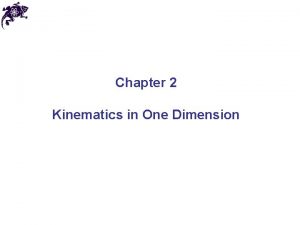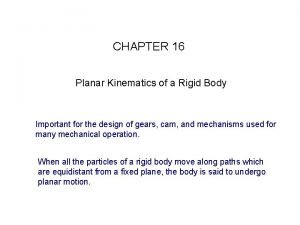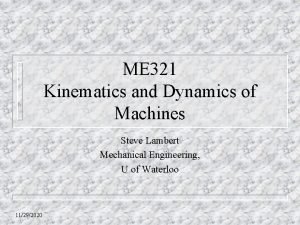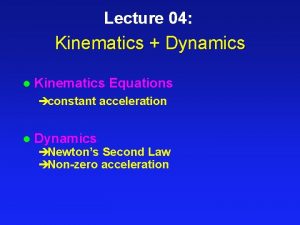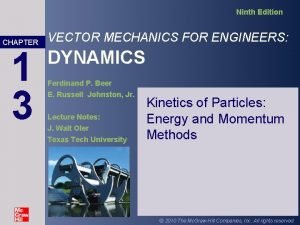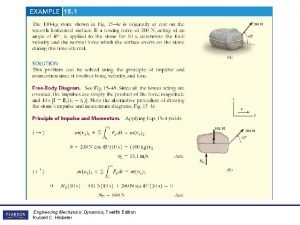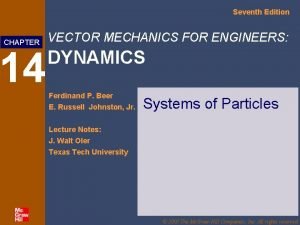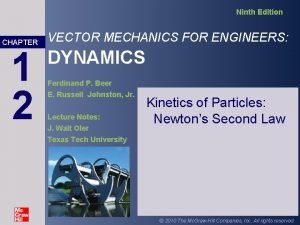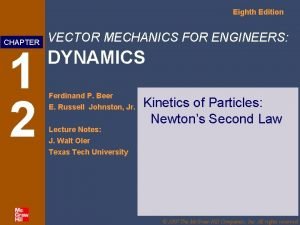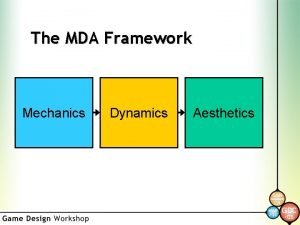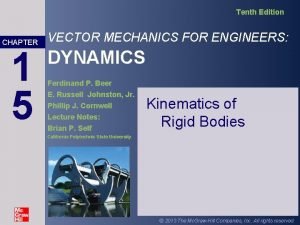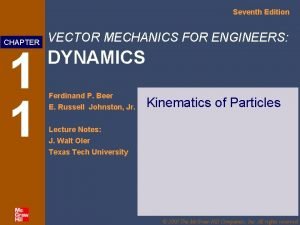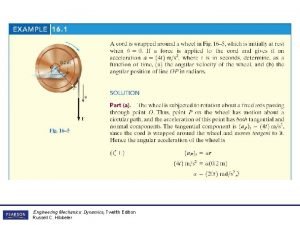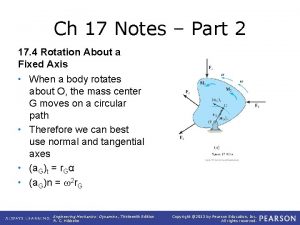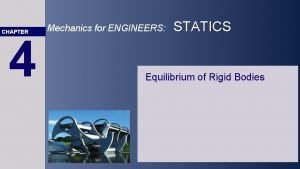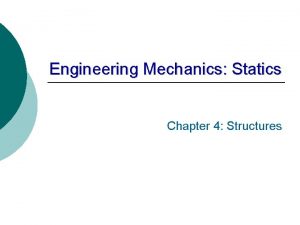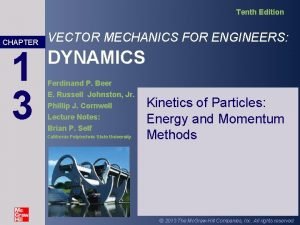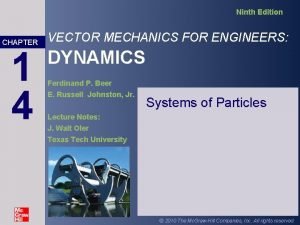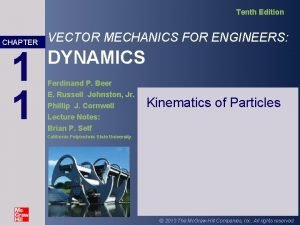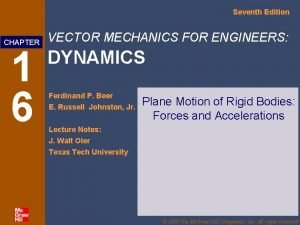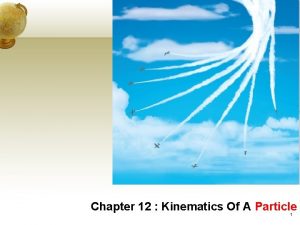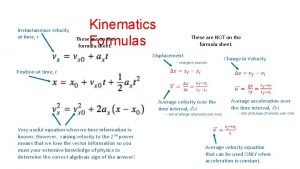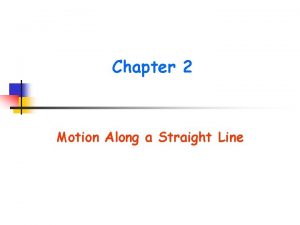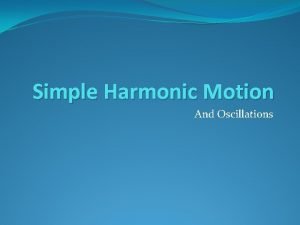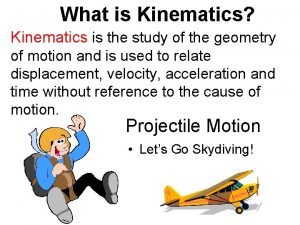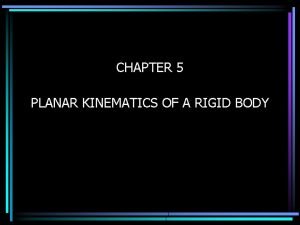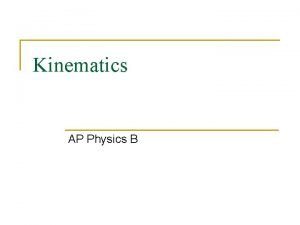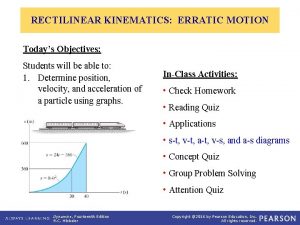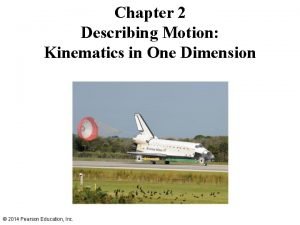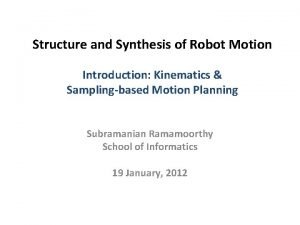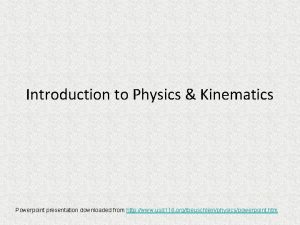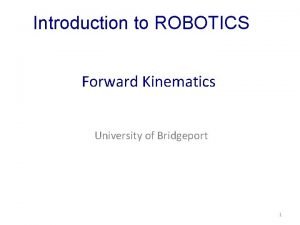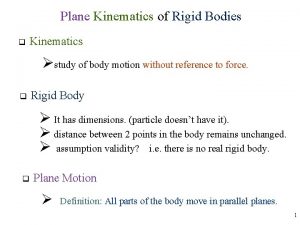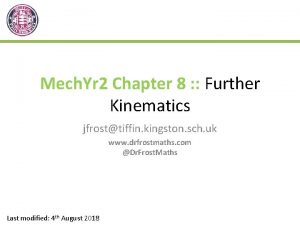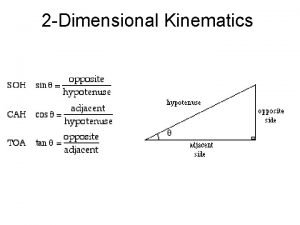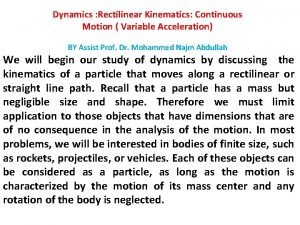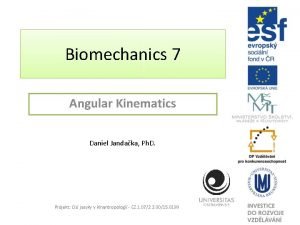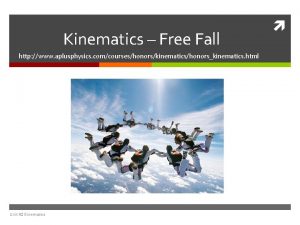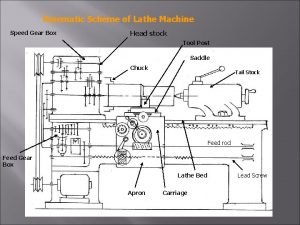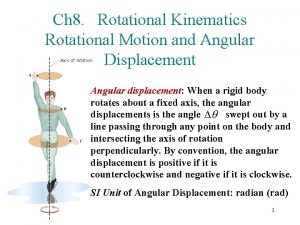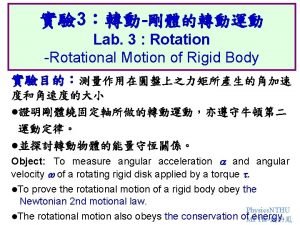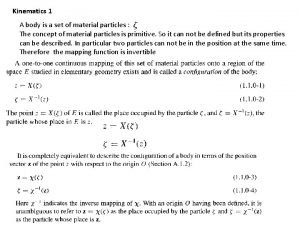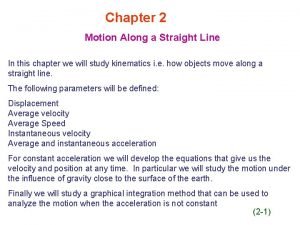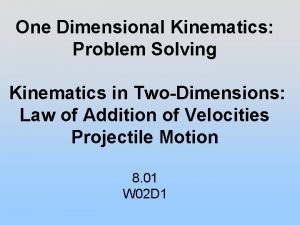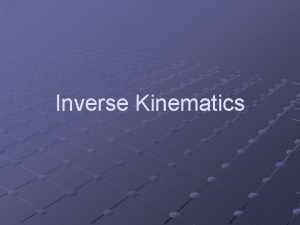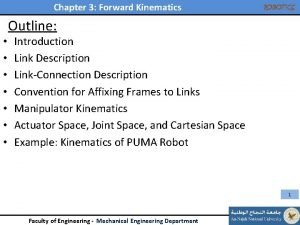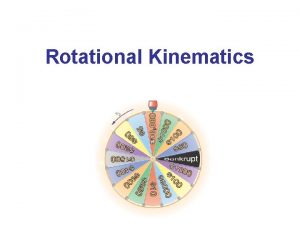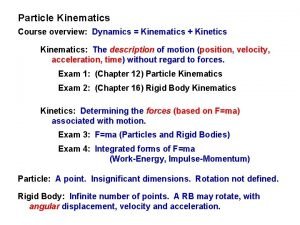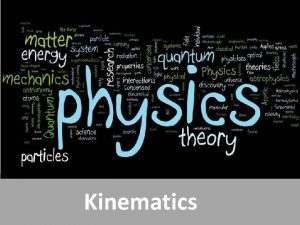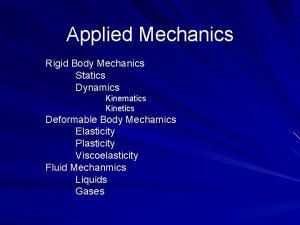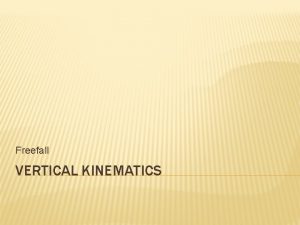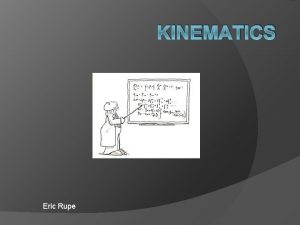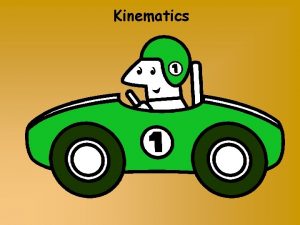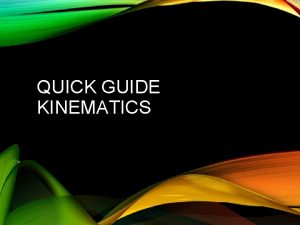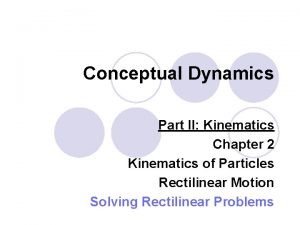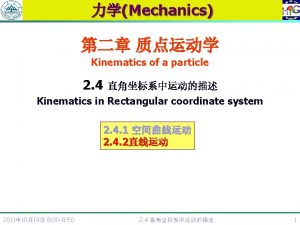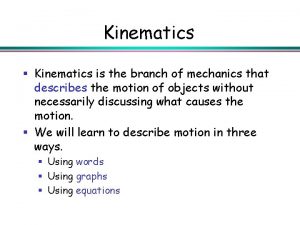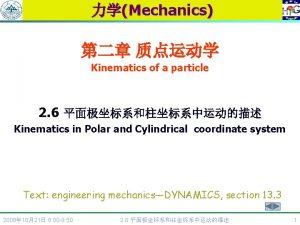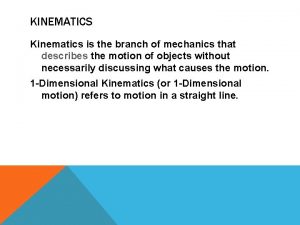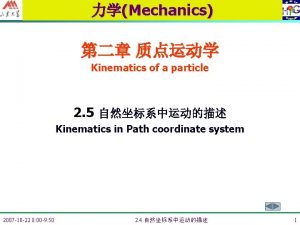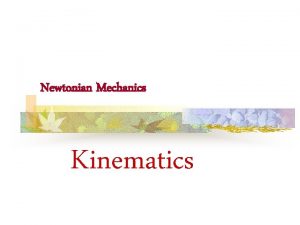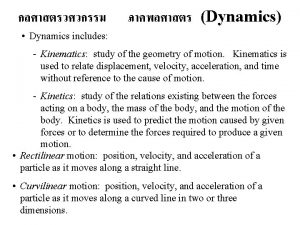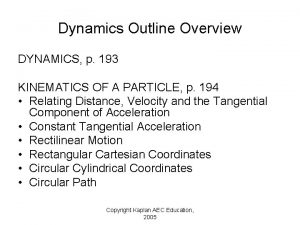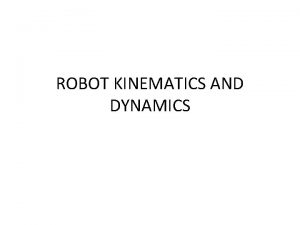Mechanics Kinematics Dynamics Mechanics Kinematics Description of how




















































- Slides: 52

Mechanics Kinematics Dynamics

Mechanics Kinematics Description of how objects move Dynamics Deals with forces and why objects move as they do

Kinematics Classical Translational Rotational Relativistic

Kinematics Translational (1 -D) x (position) v = dx/dt (velocity) a = dv/dt = d 2 x/dt 2 (acceleration)

Kinematics • Translational (3 -D):

Kinematics How are x, v, a and t related?

Kinematics How are x, v, a and t related? Consider special case with constant acceleration:

Kinematics (a = constant)

Kinematics (a = constant) Always true

Kinematics (a = constant)

Kinematics (a = constant) Always true

Kinematics (a = constant)

Kinematics (a = constant)

Kinematics How are x, v, a and t related when acceleration is NOT constant?

Kinematics How are x, v, a and t related when acceleration is NOT constant? Graphical Approach Analytical Approach

Kinematics (Graphical)

Kinematics (Graphical) Area=Velocity

Kinematics (Graphical)

Kinematics (Graphical) Positive Negative

Kinematics (Graphical)

Kinematics (Graphical) Displacement

Kinematics (Analytical)

Kinematics (Analytical) Not the answer!

Kinematics (Analytical) Do units make sense?

Kinematics (Analytical) Do limits make sense?

Kinematics (Relative Velocity) vws v. BS v. BW

Kinematics (Relative Velocity) v. SB vw. B vsw

Kinematics Classical Translational Rotational Relativistic

Kinematics (Rotational) Direction of angular velocity and angular acceleration is along the axis of rotation and can be determined by the RHR.

Kinematics (Rotational) Angular acceleration is constant

Mechanics Kinematics Dynamics

Dynamics Classical Translational Rotational Relativistic

Dynamics (Translational) Newton’s Laws

Dynamics (Newton’s Laws)

Dynamics (Translational) Conservation of Momentum

Dynamics (Translational) Impulse

Dynamics (Translational) Impulse - Graphical

Dynamics (Translational) Impulse - Graphical +Impulse -Impulse

Dynamics (Translational) Conservation of Momentum and Kinetic Energy

Dynamics Classical Translational Rotational Relativistic

Dynamics (Rotational) Torque: The CAUSE of a change in rotational motion

Dynamics (Rotational) Rotational Inertia

Dynamics (Rotational) Rotational Inertia

Dynamics (Rotational) Rotational Analog to Newton’s Laws

Dynamics (Rotational) Conservation Laws

Dynamics (Work-Energy Principle)

Dynamics (Work)

Dynamics (Conservation of Mechanical Energy)

Kepler’s Laws of Planetary Motion 1 st Law: The path of each planet about the Sun is an ellipse with the Sun at one focus. 2 nd Law: Each planet moves so that an imaginary line drawn from the Sun to the planet sweeps out equal areas in equal periods of time. 3 rd Law: (T 1/T 2)2 = (S 1/S 2)3 where T is the orbital period in years and S is the semi-major axis of the orbit in AU.

Kepler’s Laws of Planetary Motion 1 st Law: The path of each planet about the Sun is an ellipse with the Sun at one focus. Recall this empirical law was derived by Newton using the ULo. G and N 3 L. We did this by solving a general differential equation for the orbit of a particle subject to an inverse square law force.

Kepler’s Laws of Planetary Motion 2 nd Law: Each planet moves so that an imaginary line drawn from the Sun to the planet sweeps out equal areas in equal periods of time. Recall that for ALL central forces, angular momentum is conserved. Kepler’s second law is simply a consequence of the conservation of angular momentum for an inverse-square law.

Kepler’s Laws of Planetary Motion 3 rd Law: (T 1/T 2)2 = (S 1/S 2)3 where T is the orbital period in years and S is the semi-major axis of the orbit in AU. Recall that Newton’s version of Kepler’s 3 rd law generalizes to all orbiting pairs of masses and is used frequently in astronomy to determine the mass of a heavier object (planet or star) by measuring the orbital period of a much smaller object (moon, planet, artificial satellite).
 Aplusphysics kinematics-horizontal kinematics
Aplusphysics kinematics-horizontal kinematics A tourist being chased by an angry bear
A tourist being chased by an angry bear Rigid body
Rigid body Kinematics and dynamics of machines
Kinematics and dynamics of machines Kinematic equaitons
Kinematic equaitons Fluid kinematics definition
Fluid kinematics definition Vector mechanics for engineers: dynamics
Vector mechanics for engineers: dynamics Engineering mechanics dynamics
Engineering mechanics dynamics Vector mechanics for engineers: dynamics
Vector mechanics for engineers: dynamics Vector mechanics for engineers dynamics 12th
Vector mechanics for engineers dynamics 12th Vector mechanics for engineers: dynamics
Vector mechanics for engineers: dynamics Mechanics-dynamics-aesthetics
Mechanics-dynamics-aesthetics At the instant shown the length of the boom ab
At the instant shown the length of the boom ab Vector mechanics for engineers: dynamics
Vector mechanics for engineers: dynamics Engineering mechanics dynamics
Engineering mechanics dynamics Hibbeler
Hibbeler Mechanics for engineers
Mechanics for engineers Engineering mechanics: dynamics chapter 4
Engineering mechanics: dynamics chapter 4 Vector mechanics for engineers dynamics 12th
Vector mechanics for engineers dynamics 12th Vector mechanics for engineers: dynamics
Vector mechanics for engineers: dynamics Mechanics dynamics aesthetics examples
Mechanics dynamics aesthetics examples Vector mechanics for engineers: dynamics
Vector mechanics for engineers: dynamics Vector mechanics for engineers dynamics 12th
Vector mechanics for engineers dynamics 12th Kinematics of a particle
Kinematics of a particle Kinematics formula sheet
Kinematics formula sheet Kinematics: motion along a straight line
Kinematics: motion along a straight line Kinematics of simple harmonic motion
Kinematics of simple harmonic motion Kinematics is the study of
Kinematics is the study of Planar rigid body
Planar rigid body Kinematics all formulas
Kinematics all formulas What is erratic motion
What is erratic motion Describing motion kinematics in one dimension
Describing motion kinematics in one dimension Kinematics
Kinematics Introduction to physics ppt free download
Introduction to physics ppt free download Spherical wrist robot
Spherical wrist robot Plane kinematics of rigid bodies
Plane kinematics of rigid bodies Dr frost further kinematics
Dr frost further kinematics Salmon often jump waterfalls to reach
Salmon often jump waterfalls to reach Variable acceleration definition
Variable acceleration definition Angular velocity biomechanics
Angular velocity biomechanics Poe final exam
Poe final exam Aplusphysics ucm gravity answer key
Aplusphysics ucm gravity answer key Kinematics of lathe machine
Kinematics of lathe machine Coriolis acceleration
Coriolis acceleration Rotational kinematics
Rotational kinematics Constant angular acceleration
Constant angular acceleration Transport theorem kinematics
Transport theorem kinematics Motion along the straight line
Motion along the straight line Sin 37
Sin 37 One dimensional kinematics problems
One dimensional kinematics problems Forward kinematics
Forward kinematics Dh parameters
Dh parameters Angular acceleration
Angular acceleration

